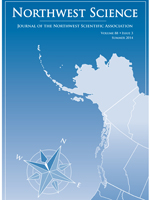Removal of invasive plants to restore native community structure and function is an important component of riparian management in the Pacific Northwest, USA. However, little is known about the role of habitat factors and species' traits in mediating recovery of native riparian systems following removal of invasives. We experimentally investigated the response of riparian understories to removal of Bohemian knotweed (Polygonum x bohemicum). We measured abundance, diversity, and composition of herbaceous and woody species before and for two years after removal. Knotweed removal resulted in rapid and abundant colonization of native woody species and of native and non-native forbs. Variation in the responses of these groups was most commonly associated with two habitat factors, height above channel and depth of knotweed litter. Knotweed litter benefited native forbs (predominantly forest perennials) relative to non-native forbs (predominantly light-demanding annuals). Natives, which are adapted to natural burial by canopy litterfall, showed a neutral response to litter depth, but non-natives showed a negative response. These results illustrate that knotweed removal can be highly effective in initiating riparian understory recovery. The conditions under which post-removal legacies of invasive species can improve native community recovery is a fertile area for research and speaks to the importance of understanding the ways in which species' traits can influence management outcomes.
How to translate text using browser tools
1 October 2014
Habitat Factors and Species' Traits Influence Riparian Community Recovery Following Removal of Bohemian Knotweed (Polygonum x bohemicum)
Lauren S. Urgenson,
Sarah H. Reichard,
Charles B. Halpern
ACCESS THE FULL ARTICLE

Northwest Science
Vol. 88 • No. 3
October 2014
Vol. 88 • No. 3
October 2014
invasion legacy
Japanese knotweed
non-native plant invasion
restoration
riparian communities




